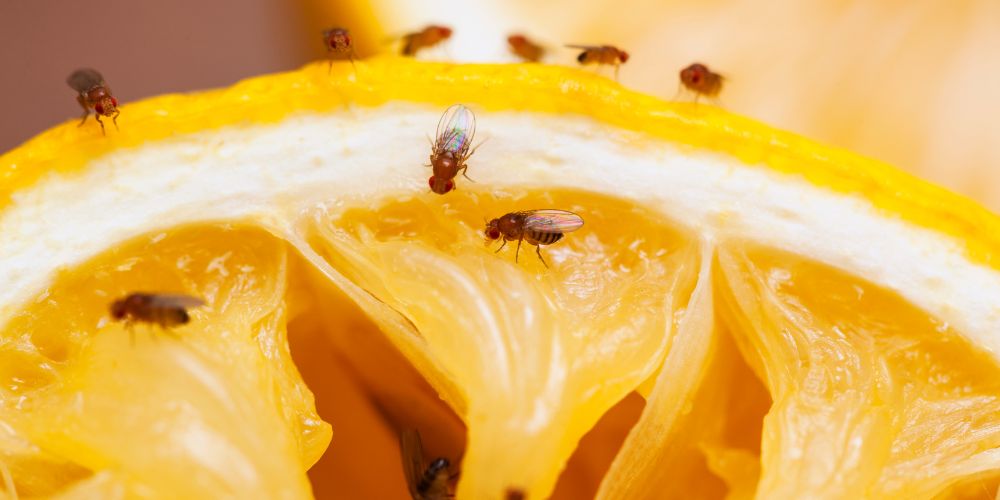How To Get Rid Of Fruit Flies

Despite their small size, fruit flies can be a massive nuisance and feel nearly impossible to get rid of. If you've ever found yourself swatting the air in frustration or wondering where they all come from, you're not alone.
These tiny, annoying pests seem to appear out of nowhere and multiply just as quickly as you can catch them.
If you’re currently trying to rid your home of fruit flies, we’ve got some great DIY solutions for you to try. But first, let’s get to know a bit more about these bugs …
Jump straight to the section on DIY Fruit Fly Traps >>
Fruit Fly 101
Fruit flies are small insects, measuring about 3 to 4 millimeters in length. They belong to the family Drosophilidae, which includes thousands of species.
To prevent or address a fruit fly infestation, it's essential to eliminate their breeding sources and keep areas clean and dry. Properly storing fruits and vegetables, regularly emptying garbage cans and compost bins, and cleaning kitchen surfaces can help reduce the chances of fruit flies becoming a problem in your home.
In nature, fruit flies play a crucial role in maintaining the ecological balance of ecosystems. They serve as decomposers, helping break down and recycle organic matter.
They’re also an important organism in scientific research.
Fruit Flies Help WIth Scientific Research
For over a century, these tiny creatures have captivated scientists. From genetics and neuroscience to evolution and behavior, fruit flies have provided invaluable insights into fundamental biological processes.
This is because their genetic makeup is relatively simple, and they share a surprising amount of genetic similarities with humans.
In fact, they have been instrumental in unraveling the principles of genetics and inheritance, laying the foundation for modern genetics and our understanding of how traits are passed from one generation to the next.
Another major reason that fruit flies are highly valued in scientific research is their quick and prolific reproductive cycle.
The life cycle of fruit flies is rapid, lasting anywhere from 8 to 10 days under optimal conditions. Females lay their eggs near fermenting materials like overripe fruit and vegetables. (A single female can lay up to 500 eggs during her lifetime.)
The eggs hatch into larvae or maggots, which feed on the fermenting matter. After a few days of feeding and growing, the larvae pupate and transform into adults, beginning a new cycle of reproduction.
While this is a benefit in the lab, it can be a nightmare at home.
RELATED: Humans are just like fruit flies when it's hot outside ...
How Fruit Flies Get Into Your Home
It's possible for fruit flies to enter your home through small gaps around doors and windows. This is more likely to happen if you leave organic waste or compost bins uncovered can attract fruit flies or have fermenting liquids lying around, like beer and wine bottles that have not been properly rinsed out.
More often than not, fruit flies enter your home when you bring back infested produce from the grocery store or farmer's market. Once the fruit flies have emerged from the fruits and vegetables you have purchased, they start breeding in your home, making the problem even worse.
Factors That Contribute To Infestation
Factors that can contribute to the rapid development of a fruit fly infestation include:
- Warm temperatures: Fruit flies thrive in warm environments and reproduce faster in higher temperatures.
- Availability of food sources: If there are plenty of ripe and overripe fruits and vegetables available, fruit flies will have a steady food supply to sustain their population.
- Moisture: Fruit flies are attracted to moist areas, so standing water or damp organic matter can provide them with suitable breeding sites.
How To Prevent Fruit Fly Infestations
Fruit flies may be tiny, but they can quickly become a big problem if left unchecked. Taking proactive measures to prevent a fruit fly infestation is much easier than dealing with one once it takes hold. Here are some essential steps you can take to keep fruit flies at bay and maintain a clean and pest-free home:
1. Store Fruits and Vegetables Properly
The first line of defense against fruit flies is proper food storage. Keep ripe fruits and vegetables in the refrigerator to slow down the ripening process and reduce the production of attractive odors.
For items that don't need refrigeration, store them in sealed containers or plastic bags to prevent fruit flies from accessing them.
2. Monitor Produce Quality
Inspect your fruits and vegetables before bringing them home from the store. Avoid purchasing overripe or damaged produce, as these are more likely to attract fruit flies.
If you notice any signs of fruit flies in your produce, remove and dispose of the affected items immediately.
3. Keep Fruits and Vegetables Dry
Fruit flies thrive in moist environments, so it's essential to keep fruits and vegetables as dry as possible. After washing produce, pat them dry with a paper towel before storing them.
Avoid leaving wet sponges or dishcloths out, as these can also attract fruit flies.
4. Regularly Clean Kitchen Surfaces
Maintain a clean and tidy kitchen by wiping down countertops, tables, and other surfaces regularly. If you have any spills or food crumbs, clean them up quickly. Even the tiniest food remnants can attract fruit flies.
Also, make sure to rinse empty containers before recycling them, as the residues can entice these insects.
5. Dispose of Garbage Properly
Ensure that trash bins have tightly fitting lids and take out the garbage regularly, especially if it contains food waste.
Fruit flies will breed in any decaying organic matter, so keeping your garbage area clean and sanitary will deter their presence.
6. Clean Drains and Garbage Disposals
Fruit flies are known to breed in moist, organic-rich environments, which can include drains and garbage disposals.
Regularly clean these areas using a mixture of vinegar and baking soda to eliminate any build-up of organic matter that might attract fruit flies.
7. Maintain a Clean Pet Area
Pet food and water bowls can also attract fruit flies. Keep your pet's eating and drinking areas clean, and promptly clean up any spilled food or water.
All of this will reduce the chances of fruit flies becoming a problem in your home.
How To Get Rid Of Fruit Flies
Even if you're the most vigilant homeowner, you may still experience a fruit fly infestation. The good news is, there are steps you can take to quickly rid yourself of these pests.
If you’re trying to get rid of fruit flies, the first step is to address everything in the prevention section to ensure you have removed possible feeding and breeding grounds. This includes:
- Properly storing produce
- Removing any overripe or rotting fruits and veggies
- Cleaning kitchen surfaces
- Taking out your compost and garage (and cleaning the pails)
- Cleaning drains
- Cleaning your pet's food and water area
Once you have removed these attractants and breeding grounds, it’s time to rid your home of fruit flies altogether.
DIY Fruit Fly Traps
The primary reason fruit flies become a nuisance is their attraction to fermentation. Their keen sense of smell allows them to locate these food sources from considerable distances.
If you remove all of the food sources and ideal breeding environments for fruit flies, they should eventually die out. At least in theory …
The problem is, these little flies have a skill for finding that one place you missed. So to help ensure you really do catch them all, it’s a good idea to use their sense of smell to your advantage and set up a trap.
While you can buy flypaper strips, they aren’t always the most effective solution and they’re horrible if you accidentally get one stuck on you (or worse … your hair).
Luckily, there are lots of easy-to-make fruit fly traps you can use to rid your home of the pests. And most of them use supplies you likely already have at home.
1. The Vinegar Trap
One of the simplest and most effective DIY fruit fly traps involves using vinegar.
MATERIALS:
- A small glass or bowl
- Apple cider vinegar or white vinegar
- Dish soap
INSTRUCTIONS:
- Pour a small amount of vinegar into the glass or bowl (approximately 1/2 to 1 inch).
- Add a drop of dish soap to the vinegar and gently mix it in. (The soap helps break the surface tension of the vinegar, causing the fruit flies to sink and drown when they land on the liquid.)
- Place the glass or bowl in areas where you've noticed the most fruit fly activity, such as near fruit bowls or garbage bins.
Fruit flies will be attracted to the scent of vinegar, land on the liquid, and eventually meet their demise.
Remember to empty and refresh the trap regularly, as fruit flies can accumulate quickly.
2. The Fruit Trap
Another effective DIY trap uses the fruit flies' attraction to their favorite foods against them.
MATERIALS:
- A piece of ripe or overripe fruit
- A bowl
- Plastic wrap
- A toothpick or fork
INSTRUCTIONS:
- Choose a ripe fruit like a banana or peach, and place it in a small bowl.
- Cover the bowl tightly with plastic wrap, ensuring there are no gaps or holes.
- Use a toothpick or fork to poke several small holes in the plastic wrap.
- Place the trap in areas with high fruit fly activity.
The fruit's scent will attract the fruit flies. Once they enter through the holes, they will be trapped inside the bowl.
3. The Bottle Trap
This is my personal favourite and has never failed me.
For this trap, you'll repurpose a plastic bottle to construct a highly effective fruit fly catcher:
MATERIALS:
- A disposable plastic bottle (a water or pop bottle works great)
- Apple cider vinegar or a sweet liquid (e.g., fruit juice)
- A funnel (optional)
INSTRUCTIONS:
- Cut off the top one-third of the plastic bottle.
- Fill the bottom of the bottle with a small amount of apple cider vinegar or sweet liquid like juice.
- Invert the top part of the bottle and insert it into the bottom part, creating a funnel-like shape that leads to the liquid.
- Tape or secure the edges of the two bottle halves together.
- Place the trap in areas where fruit flies are most active.
Fruit flies will be attracted to the sweet aroma and enter the trap through the funnel. Once inside, they will be unable to find their way out.
Getting Rid Of Fruit Flies Isn’t As Impossible As It Seems
Dealing with fruit fly infestations can be frustrating, but homemade traps offer a simple and effective solution to combat these pests.
By using everyday household items like vinegar, fruit, and plastic bottles, you can easily set up traps that lure and capture fruit flies without resorting to harmful chemicals.
Just remember to maintain and refresh the traps regularly. Otherwise, they won't be much help trying to get rid of fruit flies.
Beat FOMO by being in the know!
Sign up for our newsletter today and never miss a beat.





